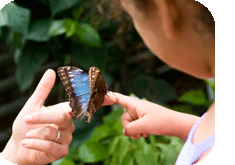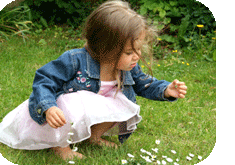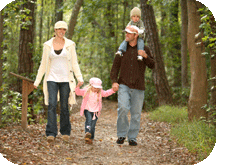
This mailer has been provided as an avenue of dispersing information related to landscape architecture in hopes of fostering greater understanding and collaboration between professions. Topics address issues that affect the built environment within which we live.
Creating dynamic play areas through the inclusion of vegetation and natural materials.
"In all things of nature there is something of the marvelous.", Aristotle
Traditional park and playground design philosophies are evolving and shifting as researchers and designers have begun to see the results of past trends in risk management, safety and design. These trends have led to static playgrounds with less than stellar play value, and infrequent patron trips. Modern design philosophies are now embracing the incorporation of plant life and other natural elements into play areas. At the core of this shift in thoughts is the fact that nature is intrinsically dynamic and ever changing and that the addition of these features to playgrounds introduces variety, change, and opportunities for creativity. Natural elements are incorporated in ways that attempt to preserve the importance for safety regulations, risk management programs and maintenance requirements. Three, of many, important factors related to naturalized play spaces are discussed below:
Lack of Exposure to Nature-  The lack of our children's exposure to nature is commonly referred to as "Nature Deficit Disorder", a phrase coined by the author Richard Louv. This phenomenon is increasingly gaining attention by researchers who are interested in determining the effects that lack of exposure to nature is having on our society. Regardless of the effects, it is unmistakable that this phenomenon is occurring. An international survey of over ten thousand children between the ages of 5-18 reported that 40% of the children felt watching television or playing games was most important to them. This number was contrasted by only 4% of children who felt saving the environment was most important to them.2 The extent to which our children are separated from nature is evident in the results of a national study of elementary school age children which showed that 84% of these children claim their primary source of learning about nature was from the media and school classrooms. Only 9% claimed home and nature itself as their primary source for learning about nature.1 As is illustrated to the left, there is no educational or experiential equivalent for holding and staring at a real butterfly for even just a few minutes. An experience like this, coupled with an insightful lesson from a parent or teacher, will far outlast any time spent reading about a butterfly's weight or what touching one feels like.
The lack of our children's exposure to nature is commonly referred to as "Nature Deficit Disorder", a phrase coined by the author Richard Louv. This phenomenon is increasingly gaining attention by researchers who are interested in determining the effects that lack of exposure to nature is having on our society. Regardless of the effects, it is unmistakable that this phenomenon is occurring. An international survey of over ten thousand children between the ages of 5-18 reported that 40% of the children felt watching television or playing games was most important to them. This number was contrasted by only 4% of children who felt saving the environment was most important to them.2 The extent to which our children are separated from nature is evident in the results of a national study of elementary school age children which showed that 84% of these children claim their primary source of learning about nature was from the media and school classrooms. Only 9% claimed home and nature itself as their primary source for learning about nature.1 As is illustrated to the left, there is no educational or experiential equivalent for holding and staring at a real butterfly for even just a few minutes. An experience like this, coupled with an insightful lesson from a parent or teacher, will far outlast any time spent reading about a butterfly's weight or what touching one feels like.
 Play Value of Nature - First and foremost, nature is always changing, providing children with renewable supplies of play materials, sensory experiences, and creeping critters. In essence, play areas integrated with natural elements are different and afford new experiences each time a child visits. Logically, this type of play area will retain its novelty over time encouraging more frequent visits. "Diverse play settings meet individual needs according to stages of development, learning styles, personality types, friendship patterns and culture."3 Research has also shown that children find symbolism in nature that directly correlates with creative play.1 Additionally, the inclusion of nature provides an educational experience promoting hands-on learning and exploration that often does not exist in traditional playgrounds. Exploration is also a fundamental form of play and an innate draw to natural settings that is critical in helping a child understand the surrounding landscape. Natural features such as inert materials, landforms, seed pods, flowers, grasses, trees, insects and other wildlife are all curious specimens worthy of childlike exploration and investigation.
Play Value of Nature - First and foremost, nature is always changing, providing children with renewable supplies of play materials, sensory experiences, and creeping critters. In essence, play areas integrated with natural elements are different and afford new experiences each time a child visits. Logically, this type of play area will retain its novelty over time encouraging more frequent visits. "Diverse play settings meet individual needs according to stages of development, learning styles, personality types, friendship patterns and culture."3 Research has also shown that children find symbolism in nature that directly correlates with creative play.1 Additionally, the inclusion of nature provides an educational experience promoting hands-on learning and exploration that often does not exist in traditional playgrounds. Exploration is also a fundamental form of play and an innate draw to natural settings that is critical in helping a child understand the surrounding landscape. Natural features such as inert materials, landforms, seed pods, flowers, grasses, trees, insects and other wildlife are all curious specimens worthy of childlike exploration and investigation.
Health Benefits of Nature and Play -  Health benefits related to natural settings have been studied extensively and are so well documented that the term "Vitamin G" is commonly used to describe our physical need for access to nature.2 Just as vitamins and minerals in the food we eat are necessary for healthy growth and development, so too is regular access to natural environments. In fact, healing gardens and play spaces are becoming increasingly popular in physical therapy and recovery programs and programs to combat childhood obesity. Less well known, however, are the benefits of natural play areas for all children's mental health, for children with autism and for children with attention deficit disorders. Scientific based research concludes, "the greener a child's play environment, the less severe their attention deficit symptoms are in general."2 Designs based on available research, "Evidence Based Design", are also proving to be very effective at creating calming and therapeutic atmospheres, particularly for children with autism.4
Health benefits related to natural settings have been studied extensively and are so well documented that the term "Vitamin G" is commonly used to describe our physical need for access to nature.2 Just as vitamins and minerals in the food we eat are necessary for healthy growth and development, so too is regular access to natural environments. In fact, healing gardens and play spaces are becoming increasingly popular in physical therapy and recovery programs and programs to combat childhood obesity. Less well known, however, are the benefits of natural play areas for all children's mental health, for children with autism and for children with attention deficit disorders. Scientific based research concludes, "the greener a child's play environment, the less severe their attention deficit symptoms are in general."2 Designs based on available research, "Evidence Based Design", are also proving to be very effective at creating calming and therapeutic atmospheres, particularly for children with autism.4
Research supporting the integration of nature into our children's play environments is quite extensive and well documented. Unfortunately all of this research can not be in this forum. Please contact O'Dell Engineering if you would like to know how to find more information related to this topic.
Prior Issues of Interest
- The Parks and Rec Budget Reduction Trend
- Artificial Landscape Water Cycles
- Dog Park Basics
- Playground Safety: What's the Big Deal?
- The Vestibular and Proprioceptive Sensory Systems
The next time you need a Landscape Architect on your project, consider O'Dell Engineering's Landscape Architecture Department.
Services include:
- Park and Playground Design
- Recreational Facility Design
- Site Planning
- Streetscape Design
- Urban Design
- Commercial Design
- Model / Production Homes
- 3-D Visualizations
- Graphic Design
- Arboriculture Consulting
- Playground Inspection
References:
1-Julie M. Johnson. Design for Learning: Values, Qualities, and Processes of Enriching School Landscapes. Landscape Architecture Technical Information Series. Washington D.C. 2009.
2-Frances E. (Ming) Kuo. Parks and Other Green Environments: Essential Components of a Healthy Human Habitat. National Recreation and Parks Association, Ashburn, VA. 2010.
3-Robin Moore. Et all. Creating & Retrofitting Play Environments: Best Practice Guidelines. Playcore Inc. and Natural Learning Initiative, College of Design. NC State University. 2009.
4-Naomi Sachs and Tara Vencnta. Prescription for play: Nature-Based Learning and Play for Autistic and Special Needs Children. http://kaboom.org/docs/documents/pdf/playschool/ Prescription_for_Play_Supplemental_Materials.pdf. Accessed 04/11/11
Author: Chad Kennedy, Landscape Architect
This informational article provided by O'Dell Engineering - 1165 Scenic Drive, Suite A, Modesto CA 95350